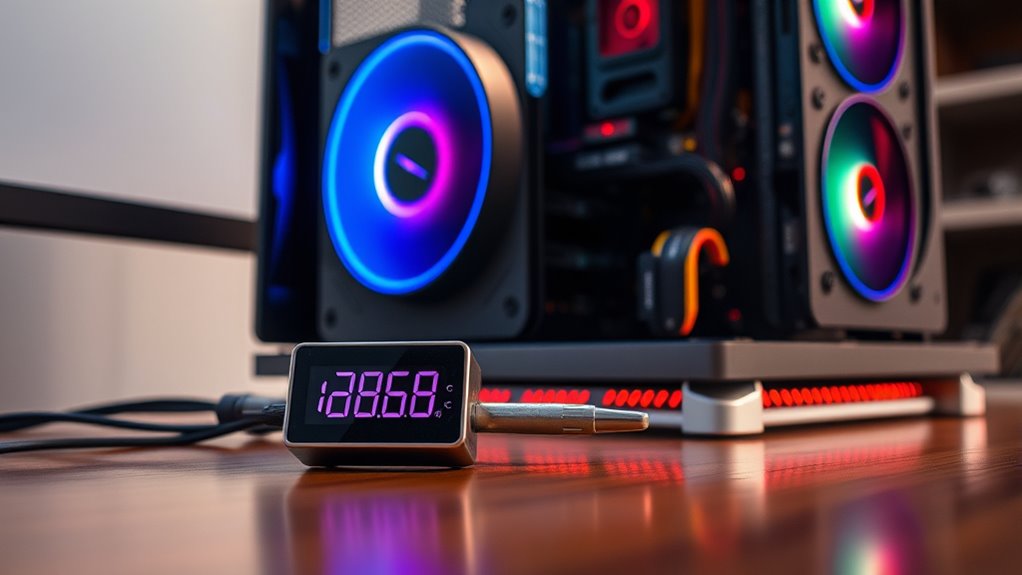To monitor your CPU temperature, you can use software tools like Core Temp, HWMonitor, or MSI Afterburner for real-time readings and alerts. For a deeper check, access BIOS on reboot using keys like Del or F2, then navigate to sections labeled “Hardware Monitor.” Alternatively, you might invest in dedicated hardware sensors for precise thermal data. Keeping your CPU cool is essential; keep exploring for additional tips on managing and reducing temperatures effectively.
Understanding CPU Temperature and Its Importance
Understanding CPU temperature is essential for maintaining ideal performance and longevity of your computer. When the CPU overheats, it can lead to serious issues, including thermal throttling, where your processor automatically reduces its speed to cool down. This not only hampers performance but can also shorten the lifespan of your components. Keeping your CPU within an appropriate temperature range guarantees that you harness its full potential without risking damage. Regular monitoring allows you to identify potential overheating issues early, enabling you to take appropriate action—like enhancing cooling solutions or improving airflow in your case. By staying proactive, you can avoid the detrimental effects of excessive heat and enjoy a more efficient, reliable computing experience.
Using Software Tools to Monitor CPU Temperature
While you might be aware of your CPU’s importance, utilizing software tools to monitor its temperature is essential for optimizing performance. There are several software options available, such as Core Temp, HWMonitor, and MSI Afterburner, that can provide real-time temperature readings. These tools not only display current temperatures but also allow you to set temperature alerts, ensuring you’re notified before overheating becomes an issue. By regularly checking these metrics, you can make informed decisions about cooling solutions or hardware upgrades. Additionally, some software can log temperature data over time, helping you identify patterns that may indicate a problem. By incorporating these tools into your routine, you’ll be better equipped to maintain your system’s health and performance.
Accessing CPU Temperature in BIOS
To access your CPU temperature in the BIOS, you’ll need to reboot your computer and enter the BIOS setup by pressing a specific key during startup, often Del, F2, or Esc, depending on your motherboard. Once you’re in, you’ll engage in BIOS navigation using your keyboard. Look for sections labeled “Hardware Monitor,” “PC Health Status,” or similar. These sections typically contain temperature settings for your CPU, allowing you to view real-time readings. Pay attention to the temperature values displayed; they indicate whether your CPU is operating within safe limits. If you notice unusually high temperatures, consider implementing cooling solutions. Remember, accessing BIOS provides a direct way to monitor CPU temperatures without relying on software tools.
Utilizing Hardware Monitoring Devices
Monitoring CPU temperature effectively can be greatly enhanced by utilizing dedicated hardware monitoring devices. These devices often incorporate advanced hardware sensors designed to provide real-time data on your CPU’s thermal performance. You can opt for external temperature gauges that connect via USB or internal monitoring tools that integrate directly with your motherboard. By using these solutions, you gain precise insights into your CPU’s thermal state, allowing for better decision-making regarding performance optimization. Many hardware monitoring devices also come with software that can log temperatures and send alerts if thresholds are exceeded, giving you the freedom to act before any overheating occurs. Investing in these tools empowers you to maintain a healthy computing environment efficiently.
Tips for Managing and Reducing CPU Temperature
Having the right hardware monitoring devices in place is only part of the equation when it comes to maintaining ideal CPU temperatures. To effectively manage and reduce CPU temperature, consider implementing advanced cooling solutions, such as liquid cooling or high-performance air coolers. Make sure your system’s airflow is maximized by arranging cables neatly and installing additional fans if needed. Regularly check and replace thermal paste between your CPU and cooler; this can greatly enhance heat transfer efficiency. Additionally, keep your workspace dust-free to prevent blockages in airflow. Monitor your CPU load and avoid running resource-heavy applications simultaneously. By proactively managing these factors, you’ll maintain a cooler, more efficient system, allowing for peak performance and longevity.
Frequently Asked Questions
What Is a Safe CPU Temperature Range for Gaming?
A safe CPU temperature range for gaming is typically between 60°C to 80°C. Effective temperature management is essential to guarantee peak performance, preventing overheating, and maintaining your system’s longevity during intense gaming sessions.
Can High CPU Temperature Damage Other Components?
Yes, high CPU temperatures can cause CPU damage and lead to thermal throttling, affecting performance. When components overheat, it can also impact other hardware, potentially shortening their lifespan and causing instability in your system.
How Often Should I Check My CPU Temperature?
You should check your CPU temperature regularly, ideally every few hours during heavy use. Utilizing temperature tools can help establish a monitoring frequency that keeps your system cool, ensuring peak performance and longevity without hassle.
Do Laptop CPUS Have Different Temperature Limits?
Yes, laptop CPUs have different temperature limits, often lower than desktops. Laptop thermal throttling occurs when temperatures exceed these limits, impacting performance. Effective CPU cooling solutions are essential to maintain ideal operating temperatures and performance.
What Signs Indicate My CPU Is Overheating?
When your CPU’s overheating like a car engine on a hot day, symptoms include frequent crashes, sluggish performance, and thermal throttling. Consider effective cooling solutions, like better fans or thermal paste, to prevent damage.

